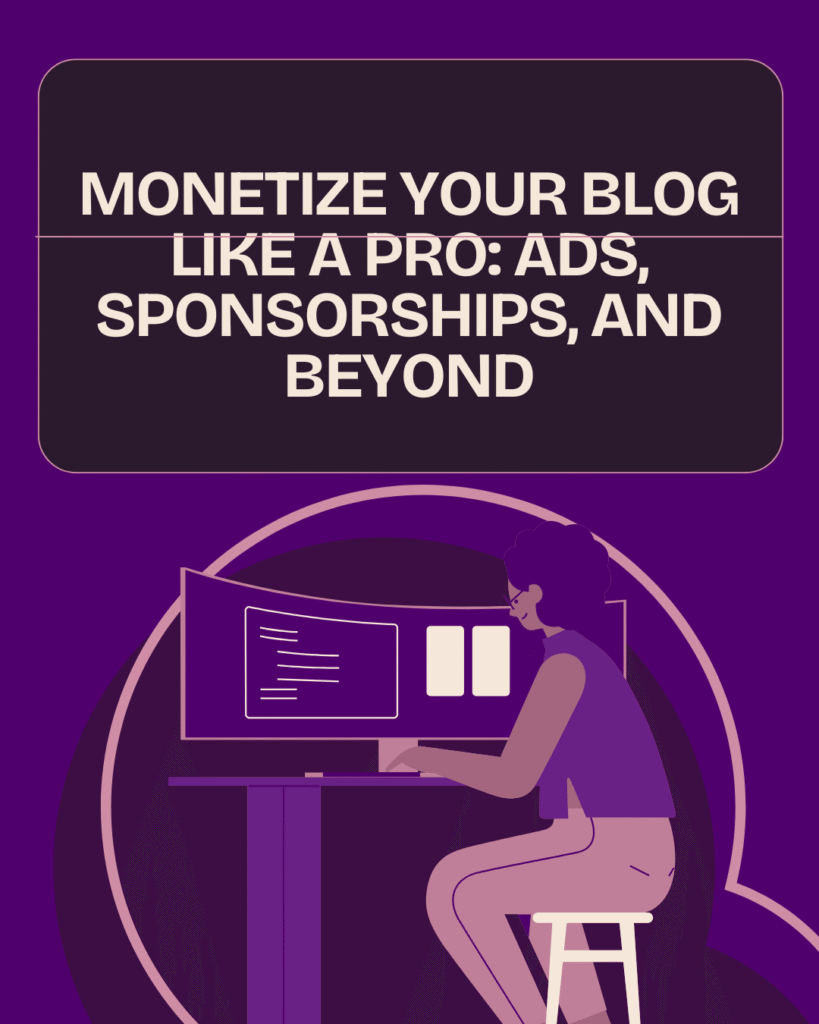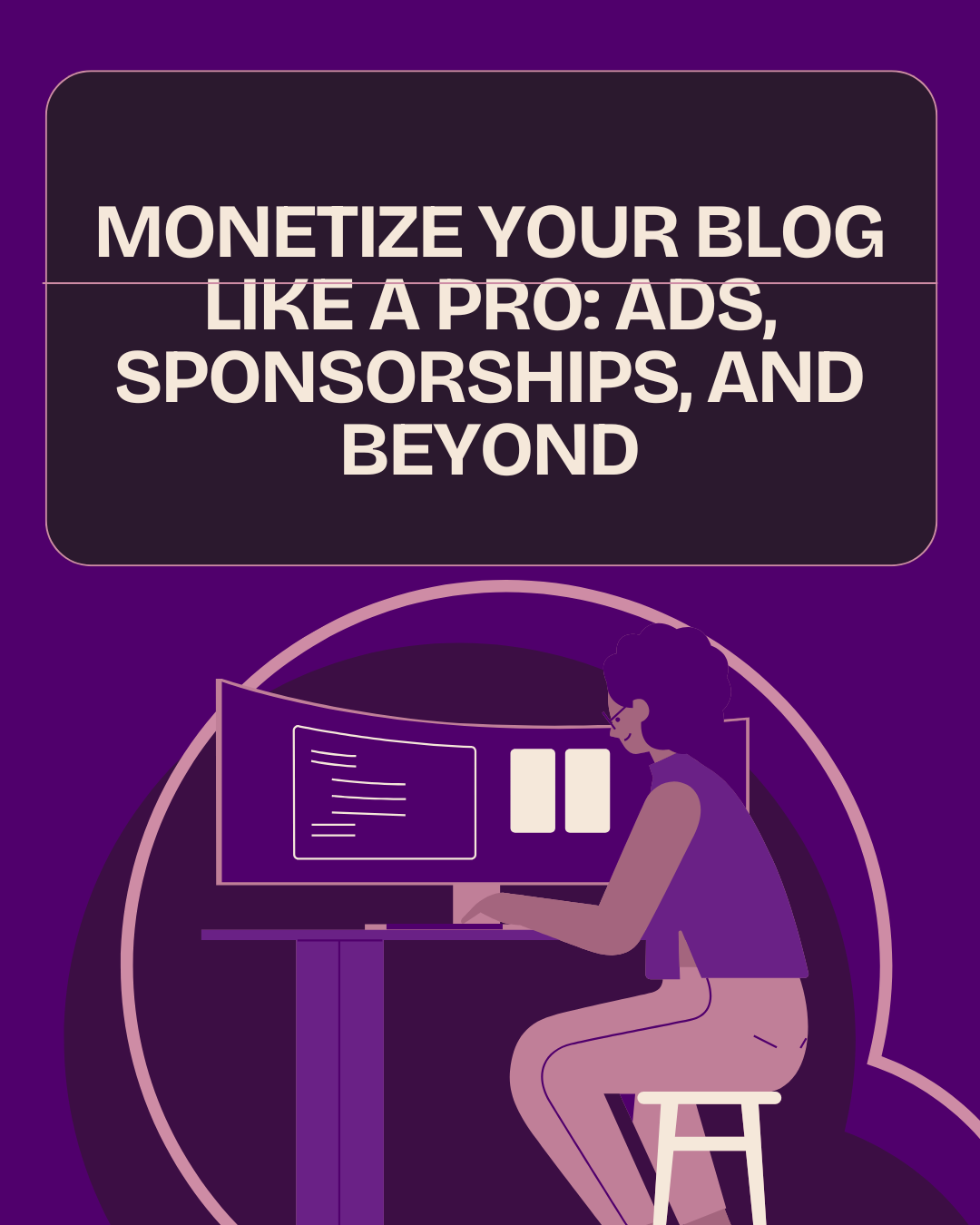Monetize Your Blog Like a Pro: Ads, Sponsorships, and Beyond
Introduction: Turning Your Blog into a Money-Making Machine
Blogging has developed from a basic online journal into a highly profitable internet business and adventure. Nowadays, writers are just not the only ones that bloggers have influenced; they have also affected the whole industry,” said a successful Blogging guru, who has got a lot to say about it. Brand builders, and even more, the ones who have echoed their voice, are the new income generators of bloggers in many different but politically correct ways. The great thing about blogging is that it gives you [the] power to turn your hobby of writing, photographing, or teaching into a full-time job, provided you have the right money-making strategies.
In case you are curious about how the best bloggers are generating such huge sums of money from their sites monthly, the reply is plain yet tactic: varied monetization. The most astute bloggers don’t put all their eggs in one basket but rather join ads, sponsorships, affiliate marketing, digital products, and services to create a strong income portfolio.
This guide will show you how to monetize your blog like a pro—dealing with everything from the classical ad and brand partnership revenue to modern income models that go beyond the basics. By the end of it, you will have a map for the blog that is unsupported financially turning into an enterprise.
1. The Foundation of Monetization for a Blog that Succeeds
You need to have a very strong support before you go to the next step of generating income. Monetization without being prepared is like trying to build a house without a foundation—letting the wind blow it down.
The First Step is Knowing Your Audience
Knowing your audience is the first step in the professional route of monetization. Your readers do not represent a number; they are real people with certain needs, tastes, and problems that may be solved by your blog. Try to make the best use of analytics tools like Google Analytics for an in-depth study of your audience’s demographics, behavior, and engagement.
After identifying the wants/needs of your readers, it becomes easier to apply the monetization strategies in a way that it will be a win-win situation for both parties. To be more specific, if you are running a health blog, then your audience could be.
Building Trust and Authority
A blogger that is not trusted by the audience is a blogger that practically has no buyers. The trust is the main form of payment in the online business world. The credibility will be built by the continuous and uninterrupted posting of top-notch content that is accurate, insightful, and of course, well-researched. Do not get involved with clickbait and misleading promotions, rather, make it your goal to enrich your readers’ lives.
When the audience trusts you, they are more inclined to click on your affiliate links, sign up for your products, and interact with sponsored content.
Traffic: The Monetization Bloodstream
Trafficking is a must for monetization. Direct your attention to providing your blog with more visibility through Search Engine Optimization (SEO), social media promotion, and networking with other bloggers. Use relevant keywords for your posts, create content that remains useful and interesting over time, and communicate with your readers via newsletters and comment sections.
The higher the number of visitors, the more avenues you have to generate income—through ads, sponsorships, and more.
2. Monetizing via Ads: The Timeless Revenue Stream
One method to make money from your blog that is always there and friendly to beginners is an advertisement. Advertising will turn your blog into a source of passive income as long as the visitors keep browsing through your content.
Display Ads
Display ads are basically banners or visual advertisements that are shown on your blog, and the managing process is usually by the ad networks such as Google AdSense, Ezoic, or Mediavine. The networks will take care of the rest by automatically placing ads on your pages that are more relevant to the users as well as your area of interest based on the user’s data.
The most important factor in display ads is the placement. The major locations-such as the middle of the content paragraphs, the top of the page, and the bars on the side—attract higher engagement. But, again, moderation is the key. Overloading ads can slow down the reader’s flow and therefore drive them away.
Types of Ad Models
When it comes to monetization via ads, you will mainly come across two models:
CPC (Cost Per Click): It is the model under which the advertisers pay you for each click that is done on the ad by the readers.
CPM (Cost Per Mille): The model pays you a fixed amount of money for every 1,000 impressions, and that is the case no matter if there were clicks or not.
Your choice of model should depend on the nature of the traffic your site receives. Blogs with high reader engagement often receive higher payouts from the CPC model, while high-traffic blogs are better suited to the CPM model.

Direct Ad Sales
After your blog gets more and more visitors, you can sell ad space directly to the brands instead of going through ad networks. This gives you more control over the price and the location of the ads. If you attract a specific audience that brands want to reach, you can charge even more. For instance, if you run a parenting blog, you can sell the space for an ad banner directly to the companies that make baby products or work in childcare.
Native and Video Ads
Native ads become a part of your blog content without any change and thus become less intrusive and more effective. Video ads are also becoming more and more popular due to their captivating format. YouTube and video ad networks are some of the platforms that can share bloggers’ earnings by short and embedded video content.
3. Sponsored Content and Brand Partnerships
Sponsorships are among the most lucrative ways for professional bloggers to monetize their blogs. Instead of depending on ad impressions or clicks, you are paid in full by the brands for advertising.
What Are Sponsored Posts?
Sponsored post is a partnership between the influencer and the marketer in which you publish the content that highlights the company’s offering. The trick is to keep it genuine—your readership must get the notion that the sponsored content is not far away from your habitual topics.
For example, a blogger specializing in travel might consider luggage, hotel, and airline companies as partners for sponsored reviews or even travel diaries.
Pricing and Disclosure
The rates for sponsored posts differ according to the traffic and influence of the content creator. A beginner would typically charge $100 per post, while a person with a high authority website might get thousands of dollars. Moreover, it is a good practice to always include the disclosure as it is the law in order to keep your audience informed.
Long-Term Brand Partnerships
Instead of considering one-off deals, plan for long-term collaborations. These partnerships not only bring in steady income but also contribute to the establishment of your authority in the niche. The corporates are also willing to work with those bloggers who match their values and provide consistent results.
4. Affiliate Marketing: Earning by Recommendation
The affiliate marketing system lets you earn a commission by just recommending other people’s products or services. If a customer uses your link to buy something, you will receive a certain percentage of that sale.
Finding the Right Affiliate Programs
Opt for programs that fit your niche and are of interest to your audience. Some of the most well-known affiliate networks are Amazon Associates, ShareASale, CJ Affiliate, and Rakuten Marketing.
Don’t do random promotions. Rather, give recommendations for products that are actually in your use and that you trust. Creating such an environment of trust will, in turn, make your readers more faithful and also will bring about an increase in the rate of conversion.
Creating Affiliate-Driven Content
The success of affiliate marketing is entirely dependent on the quality of the content you create around your links. Producing product reviews, tutorials, and comparison posts that lead the readers to take a well-informed decision are some of the ways to do that. For instance, a tech blogger could write comprehensive analyses of laptops, or software, and include a link to the retailer’s affiliate page.
Transparency and Trust
It is very important to let the audience know that you have been compensated for your recommendation. Transparency is not only ethical but it also creates trust. If the audience feels that you are honest about the commission that you earn, then they are more likely to buy from you.
5. Selling Your Own Digital Products
The process of making and then selling digital products is a very efficient means of converting your knowledge into money. This model does not give you control over the profits as high as the case with ads and affiliates but gives you full control with higher profit margins.
Digital Products Types
Depending on the niche you can make:
E-books: Educate your audience with the help of well-developed guides.
Online Courses: You may conduct courses on Teachable or Thinkific.
Templates and Printables: Sell downloadable items for productivity, budgeting, or design.
Exclusive Memberships: Let the readers pay for the access to the premium content or to the private communities.
Digital Products Marketing
Blog, email newsletters, and social media are effective tools for promoting your digital products. Providing limited-time discounts or bonuses is one way to create urgency. Customer testimonials and case studies are perfect for showing the value of your products.
Digital Product Income Scaling
When you come up with a winning digital product, make it possible for your customers to buy from you without any further actions on your part. By using ConvertKit, MailerLite, or Kajabi you can keep leads warm and thus generate steady sales.
6. Professional Services Offering
Bloggers often take their income to the next level by providing services that make use of their abilities. If you are a writer, designer, or marketer, your blog is your show case.
Services Based on Blog Popularity
Your niche will determine the area of services you can offer:
Writing or copywriting for freelancers.
Giving or consulting.
Web creating or branding.
SEO and digital marketing services.
Social media overseeing.
Make a “Hire Me” or “Work With Me” page on your website where you will give a detailed description of your services, prices, and customer reviews.
Turning Readers into Clients
Your blog’s audience has already put their faith in your expertise. You can easily turn them into clients by producing content that proves your talents—like case studies, tutorials, or free resources that demonstrate your knowledge.
7. Memberships, Subscriptions, and Exclusive Communities
Membership plans have become a popular choice for bloggers who intend to have a constant income while at the same time cultivating a community of loyal followers.
By charging a small fee every month or every year, you can offer the members special advantages such as private newsletters, premium articles, or personal support. There are platforms like Patreon, Substack, and Buy Me a Coffee that simplify this process of establishment.
Creating Value for Members
The secret to holding members is value always. Produce hot-off-the-press content, organize live Q&A sessions, and give out downloadable resources. Let the members feel as if they are in an exclusive group where they get insider access to your expertise.
8. Email Marketing: Monetization’s Secret Weapon
Email marketing is undoubtedly the spine of every blogging business that is successful. Your email list is the most reliable link to your audience and also one of the best means of making money.
Building an Email List
Attract people to sign-up with things like free guides or templates. Put the opt-in forms all over your site, especially within your blog posts and pop-ups.
Nurturing Your Audience
Remember that you are not just selling to your email list. Sharing your valuable content, personal stories, and tips will help you build a strong relationship with your audience. When you eventually promote your products or affiliate links, the audience will be more tolerant.
Email-based Revenue Streams
Your list can be monetized via:
– Your own product promotion.
– Affiliate offer.
– Sponsored email placements.
– Paid newsletter subscriptions.
Usually email audience turns out to be more loyal and thus converting better than random visitors from the blog.
9. Diversifying and Scaling Your Blog Income
After you have created multiple monetization channels, diversification becomes the next step. It is dangerous to rely solely on one source of income—ads might fluctuate, sponsors may stop their campaigns or affiliate programs might reduce their commissions.
Mix ads, affiliate marketing, digital products, and services to establish the income you want. Monthly revenue analysis will help you find out which methods are performing best. Make these ones that bring in the most profit the focus of your time and effort.
Automating and Outsourcing
With the growth of your blog, time management will become a crucial skill for you. Use the tools like Buffer for social media and ConvertKit for emails to automate the tasks that repeat the most. Hire freelancers for the design or content creation tasks while you concentrate on strategy and growth.
10. Managing Your Blogging Finances
The blogging income you get must also be managed properly. Act as if your blog were a business. Keep a record of all the sources of your income, also document your expenses (for instance, hosting, plugins, or tools), and prepare for taxes.
Utilize accounting software such as QuickBooks or FreshBooks to have an organized and efficient finance management. Reinvest a certain percentage of your profit in the form of better website design, advertisements, or professional courses.
11. Common Mistakes to Avoid When Monetizing
Inadequate income from blogging by many bloggers is largely attributed to mistakes that seem simple but can be easily avoided:
Placing too many ads on the site to the point of overloading it.
Marketing affiliate products that are not relevant.
Neglecting SEO and traffic generating activities.
Not being clear about the sponsored content.
Being short in focus on income and long in focus on growth.
Understanding these mistakes will help you to keep your monetization process sustainable.
12. The Future of Blog Monetization
The world of blogging is changing all the time. The main tools for the future are AI, video content, and social media. These changes are allowing bloggers to get extra profits very quickly. Now writers are mixing up their articles with podcasts, short videos, and social media runnings to keep different streams of income going.
To be the winner, one should keep learning, take new skills, and adjust according to the audience’s changing behavior. The future is for those people who come up with new ideas.
Conclusion:Becoming a Professional Blogger and the Path to Real Wealth
Monetizing your blog like a pro isn’t about quick money—it’s about building a sustainable business around your passion. Ads and sponsorships may be the starting point, but long-term success comes from diversifying income and continuously delivering value to your audience.
Start small, stay consistent, and always prioritize authenticity. Whether through ads, sponsorships, or digital products, your blog has the potential to become a powerful income-generating asset.
So take action today. Create, promote, and monetize with purpose—because the next professional blogger earning a full-time living online could be you.


